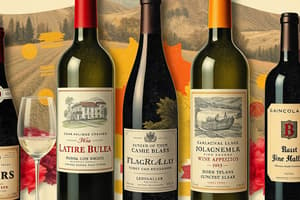Podcast
Questions and Answers
What is the primary purpose of wine laws?
What is the primary purpose of wine laws?
- To enhance marketing techniques for wine producers.
- To dictate the pricing strategies for different wine brands.
- To regulate the distribution of wine in various markets.
- To ensure the wine's origin and safety from fraud. (correct)
How do geographical delimitation in wine laws primarily benefit wines?
How do geographical delimitation in wine laws primarily benefit wines?
- By simplifying the blending processes in winemaking.
- By establishing a unique identity for wines from specific places. (correct)
- By standardizing the pricing of wines across regions.
- By allowing any wine to be labeled under a prestigious name.
What factor significantly influences the character of wines according to wine laws?
What factor significantly influences the character of wines according to wine laws?
- The types of grapes used irrespective of their origin.
- Market demand and supply chains.
- Geographic boundaries and the environment. (correct)
- Brand popularity and marketing.
Which of the following statements about EU wine regulations is true?
Which of the following statements about EU wine regulations is true?
Which of the following is NOT regulated by wine laws?
Which of the following is NOT regulated by wine laws?
What is the minimum percentage of grapes that must come from the specified American Viticultural Area (AVA) if it is stated on the label?
What is the minimum percentage of grapes that must come from the specified American Viticultural Area (AVA) if it is stated on the label?
Which of the following is true regarding wines labeled with the state of California on the label?
Which of the following is true regarding wines labeled with the state of California on the label?
What is the minimum percentage of grapes required from a specific grape variety when that variety is stated on the wine label?
What is the minimum percentage of grapes required from a specific grape variety when that variety is stated on the wine label?
What was the first American Viticultural Area (AVA) established?
What was the first American Viticultural Area (AVA) established?
What is the total number of American Viticultural Areas (AVAs) in the United States?
What is the total number of American Viticultural Areas (AVAs) in the United States?
How many AVAs are located in California?
How many AVAs are located in California?
Which legislation allows for the use of Geographical Indication (GI) in Australia?
Which legislation allows for the use of Geographical Indication (GI) in Australia?
What is the minimum percentage of grapes required from a defined Geographical Indication (GI) in Australia?
What is the minimum percentage of grapes required from a defined Geographical Indication (GI) in Australia?
What is the maximum allowable sweetness level in Prädikatswein?
What is the maximum allowable sweetness level in Prädikatswein?
Which quality level in German wine legislation cannot be chaptalized?
Which quality level in German wine legislation cannot be chaptalized?
What is a requirement for wines classified as Qualitätswein?
What is a requirement for wines classified as Qualitätswein?
The Denominazione di Origine Controllata (DOC) system is primarily concerned with which of the following?
The Denominazione di Origine Controllata (DOC) system is primarily concerned with which of the following?
Which of the following designations was introduced to discourage 'super wines' that were previously categorized as Vino da Tavola?
Which of the following designations was introduced to discourage 'super wines' that were previously categorized as Vino da Tavola?
Which German wine classification allows for chaptalization?
Which German wine classification allows for chaptalization?
What distinguishes a wine labeled as 'trocken'?
What distinguishes a wine labeled as 'trocken'?
Which of the following is true regarding wines under the DOCG category?
Which of the following is true regarding wines under the DOCG category?
Flashcards are hidden until you start studying
Study Notes
Wine Laws
- Wine laws ensure the origin and safety of wine, protecting consumers from fraud.
- Regulations cover protected designations, labeling, classification, permitted additives, vineyard practices, and cellar processes.
Geographical Delimitation
- Establishes a unique identity for wines from specific locations.
- Guarantees wine origin.
- Based on the belief that different environments produce distinct wine characters (terroir).
- Legislation varies by country, with European laws often stricter.
- The EU established its own set of regulations (2009) to unify legislation.
- EU regulations represent a minimum standard, allowing countries to have more stringent requirements.
PGI
- Protected Geographical Indication
- Landwein is a German term referring to wine with 85% grapes from one of 26 designated regions.
- Must be trocken (dry) or halbtrocken (semi-dry).
Wine without Geographical Indication
- In German, this category is referred to as "Wein."
Qualitätswein
- Must come from one of 13 designated anbaugebiete (growing areas).
- Follows specific rules for each region.
- Chaptalization (addition of sugar) is permitted.
Prädikatswein
- Represents the highest quality level in German wine legislation.
- Must come from one of the 13 designated anbaugebiete.
- Chaptalization is not allowed.
- Classifications are based on must weight, not geographical boundaries.
- All classifications (from Qualitätswein to Auslese) can be produced with or without residual sweetness.
- Dry wines typically have the designation "trocken" on the label.
Italy
- Denominazione di Origine Controllata (DOC) system introduced in 1963.
- Sets regulations for maximum yield, grape variety, viticulture, vinification, alcohol content, and minimum maturation/storage for each DOC.
- First DOCs awarded in 1966.
- After 5 years, DOCs can apply for Denominazione di Origine Controllata e Garantita (DOCG) approval.
- DOCG category introduced in 1963, with first awards in 1980 (e.g., Vino Nobile di Montepulciano, Brunello di Montalcino).
- In 1992, Goria's law introduced the Indicazione Geografica Tipica (IGT) category to discourage "super wines" classified as Vino da Tavola.
USA
- AVA (American Viticultural Area) system overseen by the Tax and Trade Bureau (TTB).
- Each AVA is defined by geographical and climatic boundaries, allowing for significant production freedom.
- First AVA established in 1980: Augusta AVA, Missouri.
- Napa Valley received AVA status in 1981.
- With the geographical AVA on the label, at least 85% of the grapes must come from the indicated AVA.
- With County/ State/ Country on the label, 75% of the grapes must come from the specified location.
- Exception: California and Oregon require 100% of grapes to be from those states.
- Washington State requires a minimum of 95%.
- With the grape name on the label, 75% of the grapes must be the specified variety.
- Exception: Vitis Labrusca grapes only require a minimum of 51%.
- If "Single Field" is on the label, 95% of the grapes must come from the specified field.
- For AVA wines with a vintage on the label, a minimum of 95% must be from the specified vintage.
- For state/country wines with a vintage on the label, a minimum of 85% must be from the specified vintage.
- "Organic Wine" cannot be labeled with "sulphites."
- Alcohol content must be stated on the label +/- 1.5%.
- AVA is not displayed on the label.
American Viticultural Areas
- Total of 269 AVAs in the United States.
- 149 AVAs are located in California alone.
- Napa Valley has 16 AVAs.
- First AVA established in 1980.
Australia
- The Wine Act grants producers significant freedom in winemaking, drawing inspiration from European models but allowing for creativity.
- Historically, regulations focused more on grape variety and producer than origin.
- Geographical Indication (GI) introduced in 1993.
- A GI requires 85% of grapes to come from the GI area if indicated on the label.
- GIs are based on states, such as South Australia.
- GI refers to Australian wine zones, regions, or subregions.
- Zones are divisions of a state (e.g., Barossa, Limestone Coast).
- Regions are part of a zone (e.g., Barossa Valley and Eden Valley within the Barossa).
Studying That Suits You
Use AI to generate personalized quizzes and flashcards to suit your learning preferences.




